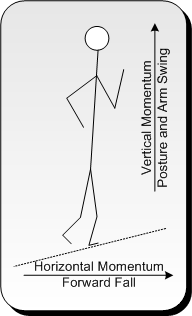
In Chi Running you move our center of mass in front of your ankles so gravity pulls it downward causing you to fall forward. The momentum of the forward fall pulls you horizontally. This works well on the flats but when you encounter an uphill, you need to not only move forward but also upward. You can continue to use the forward fall on the uphill to create horizontal momentum but you also need to create vertical momentum and you want to do this without using the muscles in the legs and feet. Vertical momentum is created using both posture and arm swing.
Posture
You first push upward with your posture. This creates a vertical force in the opposite direction of gravity to make you lighter on your feet.
Try the following drill to learn and feel how this works:
(1) Completely slouch your posture and drop your focus into your feet and feel the weight on you the bottoms of your feet and arches. This is your body weight due to gravity.
(2) Now image your head is a balloon and the rest of your body is a string. Push your head upward until you are as tall as you can be, as if the balloon is pulling up on the string to straighten your posture. Do this and feel the weight lessen on your feet and arches.
Perform the drill a number of times to really convince yourself … slouch your posture, note the weight on your feet and arches and then push upward with your head and feel the weight lessen once again. When you feel less weight this means you are lighter on your feet and will have an easier time moving up the hill in a vertical direction. (Note: Your posture should be aligned and tall whenever you are Chi Running and you should just be re-verifying it is correct on the uphill).
Arm Swing
The next thing you do is change the way we swing our arms to create additional vertical momentum.
Try the following to learn and feel how this works with the posture drill:
(1) Completely slouch your posture and drop your focus into your feet to feel the weight on you the bottoms of your feet and arches. Now start throwing punches straight downward towards the ground and feel the increase in weight on your feet and arches. The downward punching is meant to demonstrate how your arms can be used to create momentum. However, momentum in the downward direction increases the weight on our feet and arches and is counterproductive.
(2) Now push upward with your posture, completely relax all the muscles in your legs and feet and start driving your arms not forward but upward towards the sky. It is more than just moving the arms in the upward direction. You need to drive hard enough to generate an upward force so that you will feel much less pressure on the bottom of your feet with each punch. In fact if you drive hard enough and with completely relaxed lower legs and feet, you can generate enough upward momentum to cause your heels to lift off the ground with each forward arm swing. Wow, you are so light on your feet they actually leave the ground!
Putting it together
How do you put this all together for an uphill? As you approach the uphill you:
(1) Push upward with your posture;
(2) Increase you lean into the hill to ensure you are not leaning backward where gravity will actually pull you backward.
(3) Decrease your stride length
(4) Relax all the muscles in your legs and feet
(5) Keep your heels down when your feet are in contact with the ground so you don’t come up onto the balls of your feet and engage your calf muscles
(6) Drive your arms upward towards the sky and feel the vertical momentum pull you up the hill. The steeper the hill the more forcefully you drive the arms.
You may actually be breathing hard from the amount of work performed by your arms. This is OK because the intent is to save the legs and feet from expending additional effort to climb the uphill.





 Current Issue
Current Issue Previous Issue
Previous Issue Prior Release
Prior Release
